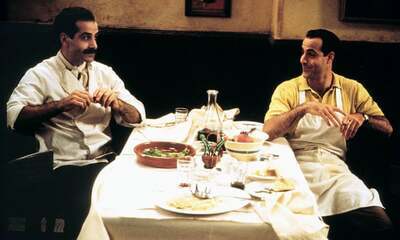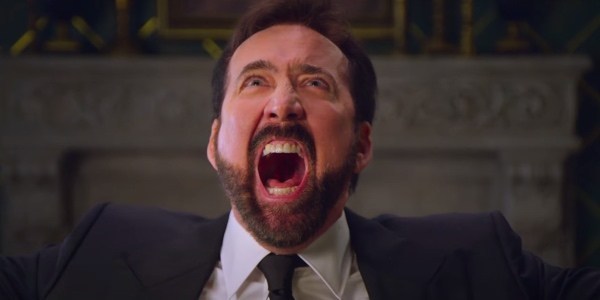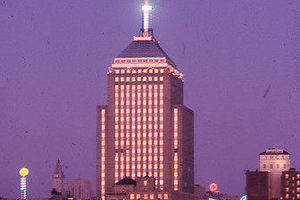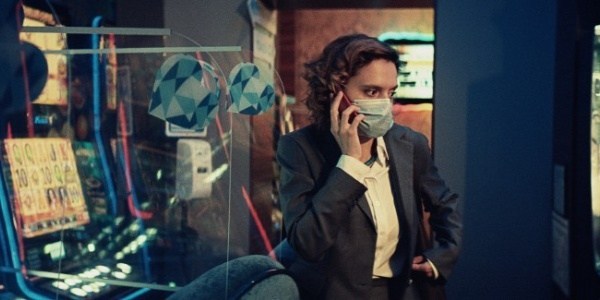Director Ansel Faraj On Making LOON LAKE, Blaspheming And Burning Down The Church In The Rain
Independent filmmaker Ansel Faraj started young, and he still is young. The writer/director just turned 29, but you wouldn’t know that looking at his resumé, which already is into double digits on directorial credits. His latest outing, Loon Lake, which is now available on Blu-ray and video on demand, is a horror-thriller based on an actual local legend in Minnesota, which he co-wrote with Nathan Wilson, who co-stars in the movie with co-producer Kelly Erin Decker. TV and movie veterans David Selby and Kathryn Leigh Scott, who both also starred on the cult favorite Gothic soap opera Dark Shadows, are featured. Dark Shadows casts a long shadow over Faraj’s trail to the screen.
Faraj spoke exclusively with Film Inquiry.
Jim Dixon for Film Inquiry: I gather that Loon Lake has its genesis in an actual local legend or a bit of folklore.
Ansel Faraj: It comes from this rural legend in that area [of Minnesota] of Mary Jane, the witch of Loon Lake. Everybody has their own interpretation of the legend. Some people say there’s three witches buried in the graveyard, some people say there’s no witch, it was all invented by the guy who ran the gas station in the fifties and just wanted traffic, but it’s all rooted in this area. And my friend Nate Wilson, who co-wrote the film and plays Louis grew up with this legend. And as long as I’ve known him, he’s been talking about it saying “I want to make this into a movie, I want to make this into movie.” And then finally did.
50 Years Ago, Vincent Price Would Be Walking Out to Have the Witch Beheaded…
I think the fact that it’s based on something that’s unique and local gives it a very individual edge, and yet at the same time when I’m watching the prologue, I’m thinking “Wow, if he’d made this like fifty years ago, it would be Vincent Price walking out to have the witch beheaded.”
Ansel Faraj: I can’t deny Witchfinder General and Blood on Satan’s Claw were huge, huge influences. I was banned from bringing up Witchfinder General during the filming of the movie because I talked about it so much and made everybody watch it and drove them all crazy — I really wanted that atmosphere of the Earth and the whole John Coquillon photography that folksy vibe, I guess you could call it. I desperately wanted that in the movie. I’d always wanted to make a folk horror piece. So when Nate kept talking about it, this was like a perfect opportunity to work in that realm. Sorry, that was a really long rant! [laughs]

No, no, not at all. There is nothing wrong with an interview subject who can give answers. That’s fine because it makes my job a lot easier.
Ansel Faraj: I’m passionate, man!
I like passion. Passion is good. Now, not to put too fine a point on it, but I gather you just celebrated your 29th birthday.
Ansel Faraj: Yeah, two Sundays ago.
Well, one, Happy Birthday, that makes you about the same age as my daughter. Two, I find it really interesting that someone as young as you has such an obvious fondness for some of the things that defined my childhood.
Ansel Faraj: [laughs] I get that a lot.
Dark Shadows… As Bedtime Stories…?
Clearly, we’re both Dark Shadows fans…
Ansel Faraj: Yeah.
Although I saw it first run — I’m happy to see the cult spread. You’ve got two of my favorite Dark Shadows cast members in Loon Lake: David Selby, who is brilliant in this movie, by the way — wonderful wonderful performance — and Kathryn Leigh Scott, who is simply one of my favorite actresses. How did you link up with these people?
Ansel Faraj: Well, to begin with, my mom grew up with the show. She was one of the kids that ran home from school to watch Dark Shadows. In 1986, Kathryn published her first book, My Scrapbook Memories of Dark Shadows. She bought it and had it autographed and the whole ordeal, and then I came along, and she would use to tell me the story arcs from the show as bedtime stories, so I would be hearing about when Julia tried to cure Barnabas and turned him old…
Wow. Your mother sounds so different from my mother.
Ansel Faraj: [laughs] So I grew up with that — hearing this stuff as bedtime stories, and then looking at the [Kathryn Leigh Scott] book I would also like to see the behind-the-scenes photographs of the making of the show, or making House of Dark Shadows and that was all sort of fascinating. I was young at the time, probably like only three or four. And House of Dark Shadows finally came to videotape.
This tells you how long ago — and we rented it and my mom had never seen it, weirdly — she’d seen The Dunwich Horror at the drive-in, so I don’t understand that one. But I got to Carolyn’s staking and that freaked me out. And my mom came into the room and saw how violent it was like, What is this? and took it out. I was traumatized and yet enthralled at the same time and couldn’t stop thinking about it. I finally convinced my parents to rent the videotape again so that I could try it again. I would only make it like 45 minutes into the movie. Every time. It took me a year to finish that movie — it kept freaking me out. But I loved it.
And how old were you when you were seeing this for the first time?
Ansel Faraj: Five or six?
Okay, yeah, that’s a little young for that one.
Ansel Faraj: Right.
I was probably 12 or 13 when it came out, and the whole neighborhood made a pilgrimage down to the old State Theatre in Schenectady, New York, to see it. So I did see it for the first time on a big screen — on a double bill with Polanski’s The Fearless Vampire Killers, by the way.
Ansel Faraj: Oh, nice. That is a great film.
That afternoon had a very formative effect on my entire life.
Ansel Faraj: [laughs] Excellent!
Personally, I still consider House of Dark Shadows to be one of the greatest old school vampire movies. And it was very startling to those of us who had gotten used to seeing Barnabas being portrayed really as almost a superhero. I mean he wears a cape, he’s got superpowers, you know?
Ansel Faraj: Yeah — traveling through time…
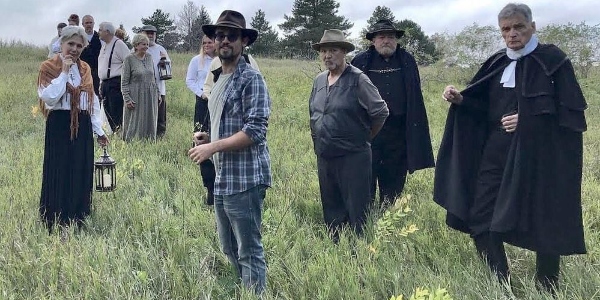
We were all used to him being basically a good guy. And he’s not acting like a good guy in this movie.
Ansel Faraj: Yeah, he’s quite brutal.
I was down for the first Sleepy Hollow International Film Festival last fall, and they did such a good job. Kathryn Leigh Scott was there for Dark Shadows Day. And they did screen House of Dark Shadows for a packed house.
Ansel Faraj: Nice. Yeah. And they showed a trailer for Loon Lake, too.
Yes, actually, we did see that down there. And Kathryn Leigh Scott speaks very highly of you, by the way. But it was great to see the effect that House of Dark Shadows still has on audiences. So your mom got an autographed copy of Kathryn Leigh Scott’s book…
Ansel Faraj: She just met her as a passing fan. And this was back in 1986. But the book was important to me because it had behind the scenes, it showed the making of a television show, filmmaking in general. And I’d never been exposed to that before. I could see cameras in the studio and how things work.
So then, you know, watching television or watching movies on TV, I started thinking about how they actually make this, you know, it doesn’t just happen and I’m watching this thing. There’s a whole process to this.
But this is all like when I’m really young and can’t quite form these ideas. Like I’m starting to put things together. Anyway, long story short. 2012 comes along with the Tim Burton [Dark Shadows movie] coming up — Well, no before that, when I was a teenager, about 15, 16, I had written my first Doctor Mabuse film. So I always had this weird pipe dream that I would have Jerry Lacy as Dr. Mabuse because Trask freaked me out as a kid.
Jerry Lacy’s a damn good actor.
Kathryn Leigh Scott: “How old did you say you were…?”
Ansel Faraj: Yes, he’s good. They’re all fantastic actors outside of Dark Shadows. And nobody ever really talks about that. Nobody ever spotlights that. But anyway, the 2012 [Tim Burton Dark Shadows] film comes along, and I was now 20, I think. I had that script still, and I was always thinking about it. And on an impulse, I just decided I’m just going to send this to Kathryn Leigh Scott.
And I was very mischievous in finding out how to get in touch with her, but I got in touch with her and I did send it to her. And I said, I’m a 20-year-old kid, I grew up with the show, I’m making this film, I wrote this part for you, would you be interested? She emailed me back a couple of hours later, and I got really excited. She said, “Okay, well send me the script, and I’ll see what you’re talking about.” She read the script, and said, “I’d like to meet with you.” And that was terrifying. So I was having casting sessions for the film in Hollywood, and she came to the audition. To just meet me.
I don’t think she believed that I wrote the scripts because she was like giving me this really weird look like, “How old are you,” like something was amiss. But then she started asking me questions like how do I see this movie, and I was able to give her concrete answers about my vision and my influences. One of the questions she asked was — I don’t know if you’ve seen the first Doctor Mabuse — but spoiler, she jumps from atop of a building — and she’s like, how are you going to do this in a garage? Because I’ve already jumped once before, in a very tight space, so how are you going to do it?
And I explained to her how we would do it, and she’s like, okay, and one thing led to another, I got in touch with Jerry, and then Jerry came on board, Lara [Parker] came on board, and all of a sudden, I was filming this movie, and getting a lot of attention at 20 years old in a garage in an eight-by-eight space with no microphone and life is very strange. [laughs]
Kathryn Leigh Scott appears I think, in two scenes in Loon Lake.
Ansel Faraj: Yeah, there was a third that got cut. But yeah.
I gather your witch, Kelly Erin Decker, had a lovely anecdote about forgetting a costume piece.
Ansel Faraj: Yeah. Her apron. Yeah, I have to say at the time I wasn’t even aware of that until Kelly told that story when we were doing the behind the scenes stuff. I mean, I was dealing with a million other things that were going on. But that’s Kathryn.
Kathryn gave her her grandmother’s apron to wear for one of the scenes in the church because she was hanging out that day to do her scene for us. Like maybe I could say something more personally about myself and Kathryn. Kathryn was sort of the gateway into the Dark Shadows land and meeting everybody. And what I find so fascinating, and just how life works, was as I had said, as we started, my mom got Kathryn’s book. And that was my first introduction to filmmaking, to Dark Shadows, to the Gothic genre. And so I learned everything first, weirdly, through Kathryn, as a kid, if distantly.
Growing up and watching the show and House of Dark Shadows over and over. And then on my first sort of, quote, professional, say that lightly, “professional” film, Kathryn is the very first person I meet, to come on board and sort of guide me — first she helped me persuade Lara Parker into being in the film, and then was like, “Oh, you should talk to Chris Pennock.” Then “Oh, you should talk to David Selby,” and “You should talk to Jim Pierson…”
Basically, she’s helped me get my start and has helped me incredibly — like how to write a press release, how to talk to actors, how to just do things in the real industry. Whenever I’ve got a problem or request or something, I call her up and she’s there. She’s like a rock, a foundation for me. And I’m incredibly, incredibly grateful to her, to know her and all her help. It’s just very funny how things work out. As I said, learning from her first distantly as a kid, and now, in real life, there she is and I’m learning from her still again.

I’ve done several phoners with her, and interviewed her in person a couple of times, and she’s always been so incredibly gracious. She’s a great storyteller. And as you know, if you read her books, she can write. Very intelligent lady, very serious actress. I was delighted to see her get a juicy cameo in your movie. I thought she was excellent.
David Selby Just Wants to Play a Guy
Ansel Faraj: She was. I wrote that part for her. David [Selby] and I kept wanting to work together…David kept saying, I just want a guy, just give me a guy. So, when we’re writing the script, I’m like, I’m gonna talk to David Selby about this, and Nate’s, like, “He’s never going to do this.” And I’m like, “I think he will because he just wants to play a guy and Emory’s just a farmer.” So I sent it over.
And then he’s all excited, he wants to do it. And then I’m “Alright, well, Kathryn’s going to be mad if we go and we do a movie in Minnesota, especially since she’s from Minnesota, so we gotta do something… So now, we tossed this idea back forth — How do you make this purposeful because this was not originally part of the script. And then we worked it out and threaded it through and then it became so like, “Nate, we absolutely needed this. We needed this character.”
We needed this extra thread because it gave so much to the pastor and what was going on in the past. I called her up and I’m like, “Kathryn, we’re doing this thing in Minnesota. And you’re gonna play David Selby’s wife. And you can’t say no.” And she just says, “When do you want me.” She was in New York at the time, and she flew out to LA, to get, I think it was her dress from when she did Little House on the Prairie. She got her costume out and all that flew with it back to New York, waited till it was time then flew to Minnesota. Her brother and sister-in-law drove her from Minneapolis, three hours down to Round Lake where we were shooting. We all spent the night together. The next day, we all drove out to Pioneer Village. And then she went and hung out with her family for a week. And I was you know, that’s just how we work.
That’s actually an inspirational story for any young filmmaker that doesn’t think they can do it. If you don’t ask, the answer is always no.
Ansel Faraj: But it’s not like I was just sitting around and said, “Oh, I’m gonna make a movie.” I’ve been doing this since I was five. After seeing House of Dark Shadows and then growing up with the Universal monster movies, specifically Phantom of the Opera — those were the two things that made me say “I want to do that because I like the way that I’m feeling when I’m watching this, so I want to do that to other people.” And so I was making movies on videotape, you know, like on old 1990s video cameras, with my action figures and my friends from school when I could rope them into one of them. I was always making movies.
[laughs] I actually remember when they first put videotape into cassettes. I was in college at the time. When I was a student filmmaker, we actually used this stuff called film. You had to get it developed and everything. And if you screwed up with the light meter, you were going to be really disappointed.
Ansel Faraj: I’d love to play with film one day, I’d love to see that.
Although I’m blown away by what digital can do — the amount of light you don’t need. I can take video with my phone in low light that you could never expose film in.
Ansel Faraj: Right? In 4k resolution too. It’s ridiculous what we can do now.
We can get better resolution off of a smartphone now than we could get off of professional quality camcorders in 1978.
Ansel Faraj: Yeah. That’s crazy. Yeah,
So Loon Lake features David Selby, an actor I’ve admired ever since Dark Shadows. He was a matinee idol playing Quentin Collins, and he’s still a ridiculously handsome man. How tall is he?
Ansel Faraj: He’s tall, man. I mean, he’s, he’s gotta be like six two to six three — he stoops, like he’s hunched over when he’s playing Emory [in Loon Lake]. But when he straightens up and becomes David Selby, like he’s a big guy. I mean, that Abraham Lincoln thing is no joke.
[David Selby played Abraham Lincoln on a 1998 episode of Touched by an Angel] And this guy has actually been on trading cards.
Ansel Faraj: Yeah. When he came in to Round Lake to shoot — this movie was supposed to be a secret — but the town is only like 150 people, and the whole town knew about this movie. But then Quentin Collins came to town and my buddy Nate, who grew up in this town was like, “I can’t believe the way that people are acting here,” because they’d see him and they’d come running up to him, gushing “Oh my god,” and it went on viral on the town’s Facebook group that Quentin was here, or Richard Channing from Falcon Crest was here, and everybody’s coming down to the pharmacy wanting to know “if David Selby’s here,” and it was, it was pretty wild. And I was like, I told you guys I knew this wasn’t gonna work. No one listens to me.
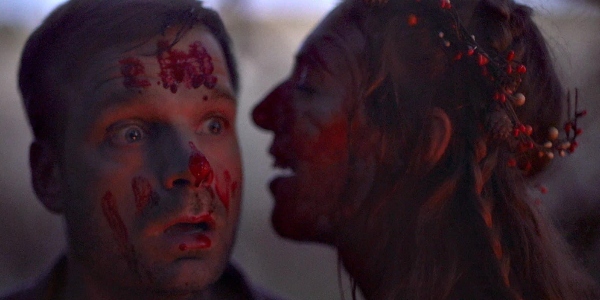
When you shoot on location, movie crews, even small movie crews, draw crowds.
Ansel Faraj: For all three of us [myself and producer/co-stars Nathan Wilson and Kelly Erin Decker], this was a passion project. As I said, Nate grew up with this whole thing and had long wanted to make this movie. And we had such a good time writing the script. We had to make this film and there were several moments where it came down to, is this even going to happen? Is this even possible? And we were just like, “We have to do this, what are we going to do if we don’t, we’re just going to sit here and have nothing, and a year is going to pass and we’re going to be nowhere — We have to do this, guys.”
Anyone who has the Blu-ray should watch the behind-the-scenes feature because it’s actually very entertaining. There’re some great insights into the realities of low-budget filmmaking, like “We can’t afford to buy fake loons.” I was so impressed with your producer’s inventiveness and the whole “Okay, we’ll figure out how to make our own” attitude.
Ansel Faraj: Yeah, Kelly [Erin Decker]. Kelly is a godsend. Kelly is a witch but like a good witch. She makes things happen.
I recently talked to some people that worked on Roommate Wanted not too long ago, and they only had the practical effects people on the set for one day and there was real worry about running out of blood.
Ansel Faraj: Yeah. I believe that. I believe that.
I believe that your prologue and flashbacks were shot at — there’s a place in Massachusetts not far from where I am called Sturbridge Village, where they’ve got a complete recreation of a colonial village — and I gather you shot at a place something like that.
Ansel Faraj: Yeah, that’s a funny story. So, um, when we wrote that, the script kept evolving as Nate and I were just writing it, like, let’s see what else could go on with the pastor? And we thought, well, “Let’s have a church,” and our original stupid idea was to jury-rig one of the old barn house rooms into a fake church thing. And then Kelly was like, “What the hell is wrong with you two? What the hell are you thinking? We need a church.”
So she got a book on historical churches in the entire state of Minnesota, with the intention of if we found a church that would be right, we’d drive up to wherever this church was and shoot the sequences there. And so we’re prepping the whole film out here in Los Angeles, and Nate would go back and see his family periodically. Just to give you some context, we started writing in November 2017 and we shot the film in September 2018. So, this has got to be March, April, summering, and we have no idea where we’re going to shoot this church.
And Nate is back home, and he’s [scouting] the fields — I don’t know what he was — I think he was finding [locations for] the altar sequences — the sacrificial scenes and hanging out with his family. He was driving back to the airport and happened to just look over off the freeway just ten minutes from his family’s farm. There’s this old historical church and all these old buildings, and he’s like, “Oh, shit, yeah, Pioneer Village, I totally forgot about that.” He came back and said, “Hey guys, I totally forgot Pioneer Village. They’ve got all these old buildings — they’ve got like three churches there…”
And so we looked into it. It turned out that his, I want to say, eighth grade English teacher was on the board of Pioneer Village. He called them up, “I’m Nate Wilson,” they know who he is, town of 150, and he tells them I’m doing this movie, and they’re like, “Yeah, just come on down.” It was so cool.
Independent filmmaking in Los Angeles is a bitch. This is LA, this is the industry town, it’s Hollywood. Everybody’s doing this here, they could give a shit about what you’re doing and what you’re not doing. It doesn’t matter. If you want anything done, you’ve got to bend over backward and have X amount of several figures to just get anything, anywhere. It’s all about the money. I’m an LA native. I’ve never shot anything outside of LA. We’re a team of three people plus our sound guy [David Karon] and camera guy [Christopher Lange], and to basically have our own backlot, with every single sort of church school, the parsonage, old houses, all this stuff at our total disposal to run around and play around — it was like the Universal backlot. I had the best time of my life. But that was where we shot the 1880s sequences. In one day, by the way,
I gathered you didn’t have a lot of time for this.
Ansel Faraj: Sixteen-day shoot, man.
Lightning on Cue
And you needed a storm and actually got one on cue.
Ansel Faraj: Oh, yeah! [laughs] I mean, you can also hear the lightning strike the church at one point. As we were shooting in the parsonage, as we’re shooting the scene, where David Selby says, “I don’t believe God…”
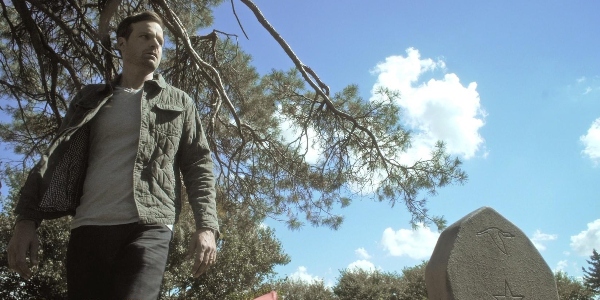
[Laughs] And lightning hits the church.
Ansel Faraj: And lightning strikes right outside. And Kathryn’s like “This is because of all the blasting that’s going on,” and I’m like, “Let’s get this done.” You know, we’re in this small, cramped, original 1800s plywood cabin that can easily catch fire with candles. And so yeah, lightning. It was fun, man. It was the best time of my life. I’m not joking.
And you actually had your leading man holding a metal umbrella over your camera operator during a thunderstorm so you can photograph the lightning strike. You’re literally asking the star to be a human lightning rod.
Ansel Faraj: I have to say that I wasn’t asking the star. The star was like, “Chris, let’s go, let’s fucking go man.” The star and the witch and me are equals on the project. There was no sort of hierarchy. That’s just who we are, because this is what we love to do. That was Nate. None of us even thought anything of that, I think until like days later. It’s lightning, torrential rain, and we’ve got cable everywhere, man. There’s only one sort of basic generator plug-in thing that Pioneer Village very kindly allowed us to use gratis.
So, we have all these cables running from the church out across the field into the barn, into this other thing and torrential rain. And metal C-stands with lights on them with cable and whatnot. And Chris, our DP, is like, “Well, let’s just roll the cable in trash bags.” So it’s like two o’clock in the morning after we’ve shot all night and blasphemed and burned the church down and everything, and we’ve got to roll all this stuff up, and it’s just us to do it. Even David Selby, he’s like, grabbing the cable at two o’clock in the morning in lightning and whatnot with big puddles of water and here’s electrical cord and just do it. You know, it’s not the best way to do it. But you got to do what you got to do. Yeah, I am. But that also tells you David is just like there to make the movie as well. No hierarchy. He’s just part of the group.
Loon Lake deals with some fairly weighty themes. I mean, it’s a horror movie, and it’s entertaining — it provides the kind of jumps the Saturday night, the date movie audience is going to be looking for, that frankly, they expect out of a movie that deals with a witch’s curse — but you’re also talking about faith, superstition versus reason, how people feel about death… I mean, it seemed to me there’s some fairly mature stuff here coming out of some frankly rather young writers.
Ansel Faraj: That’s just how we roll. We’re not gonna make a cheap horror movie, we’re gonna try to make something of substance because ultimately we’re making what we want to watch. You can go the easy way out — Nate’s original concept when he was like, 15, was a bunch of teenagers walk across the witch’s grave, and the witch comes back and kills them all. That’s the basic concept of what happens: The witch’s going to come and kill you. And you could very easily do that where you have, you know, the rotting corpses. It reminds me of — I love this movie, by the way — I’m not knocking it — an 80s film called Superstition, where you have the rotting witch coming out of the lake and slaughtering everybody. That’d be lots of fun, but none of us really wanted to make that. We were more interested in the psychological side of things.
Masters of Horror
There are aspects of Loon Lake that are almost homages to certain Stephen King novels. The relationship between Lewis and Emory is reminiscent of the relationship between Louis Creed, the main character of Pet Sematary, and his elderly neighbor, Jud Crandall. Your character Lewis is not unreminiscent of Ben Mears, the protagonist of Salem’s Lot, Which is definitely not a diss, because I think Stephen King is a wonderful writer.
Ansel Faraj: I can totally see the Pet Sematary connection. And it was especially interesting with the remake was coming out at the same time we were. I’ve read The Shining, and I read Doctor Sleep and The Dark Tower and whatnot. But don’t forget, Stephen King isn’t writing in [a vacuum]. We’ve all learned from the original masters of horror, and we’re all taking from the same tropes of writing. As far as Emory, that character could very easily become the guy [who’s] in on the dark secrets, a sinister figure. And we never wanted to do that with him.
We wanted Emory to be just a guy, just an actual honest farmer, to not know the truth to do a twist on that usual stereotype that you might expect in this kind of film. But you know, a story is a story, and there’s a saying that there are only five original stories in the world. I can tell you as a screenwriter that that’s fucking true because there’s only so many ways a certain formula can go within any specific genre.
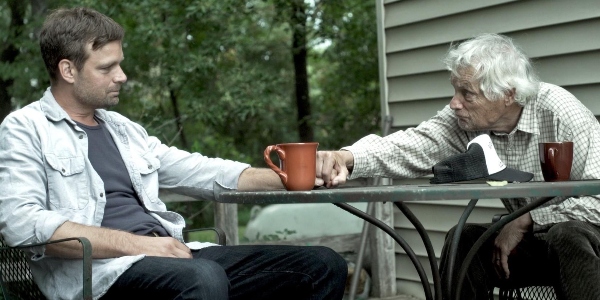
I think there’s a lot of true truth to that. Back in my grad school days, I had one professor who said that some scholars think there’s a monomyth — that there’s really only one story, and if you dig back far enough, you’ll find it.
Ansel Faraj: Right.
Storytelling is the oldest form of art and history. I mean, the first graphic novels were done on cave walls.
Ansel Faraj: Right, exactly.
This is a surprisingly mature film coming out of such young filmmakers and I think you got over the, shall we say, challenge of not being overburdened by money, because it’s a handsome film,
Ansel Faraj: I’d love to be overburdened by money, by the way. [laughs]
Idolizing Corman
I get that, but my personal hero in the filmmaking world really is Roger Corman.
Ansel Faraj: Amen.
The original Little Shop of Horrors was shot in two days. That’s impressive.
Ansel Faraj: We could talk for a whole entire week about Roger Corman because he’s in my top three, like the holy trinity of directors. He’s a huge, huge influence on me — about how to get things done. I have a Roger Corman story for you… I was 17, I had just graduated high school. I knew I wanted to make movies and Roger Corman was a huge, huge influence on me. All the Poe movies, the hippie movies — The Wild Angels all that — and his offices were right up the street. I put together my resumé of all the movies I’d made from the action figure era, to just graduated out of high school with all my high school friends and whatever crazy production that I had just assembled at the time, and cut together a reel, a quote-unquote reel and drove, or my mom drove me, to his offices, and I did my best to look like a young adult at seventeen.
No, I don’t even have a mustache. I walk up the stairs, and there are all these posters for New World Productions—like Piranha and Amarcord, which he released, so I’m like face-to-face with a Fellini. And, and I go in, and I introduce myself to his secretary and how I’d love to have an internship here and, and left my stuff. She said, “We’ll take a look, thank you for coming,” and whatnot. And so I’m all excited and panic-stricken and anxious and whatnot for like a week, week and a half, and then I got an email.
And it was a very, very nice email from Julie Corman, and she said, we liked your stuff, but you’re just a little too young right now. Because I was like, I’ll work on set, I could co-direct, I was like, trying to sell myself so badly. But they were like, no, you’re just too young. So I was a little heartbroken. But it’s all good. You know, I’ll recover.
And you’re doing fine. You’re making movies. Best of luck with Loon Lake.
Ansel Faraj: I hope I haven’t talked to your ear off, by the way.
Oh, not at all. I enjoyed it very much. I appreciate your time.
Ansel Faraj: Excellent. Thank you so much, man.
Conclusion
The last word goes to Kathryn Leigh Scott, who was gracious enough to give Film Inquiry an exclusive comment on her protegé’s burgeoning career:
Kathryn Leigh Scott: It was a joy to see Ansel, a young filmmaker I’ve worked with since his promising, early backyard efforts, make the leap to filming Loon Lake, a first-class feature. I’m proud to be in it.
Film Inquiry would like to thank Ansel Faraj fro taking the time to speak with us!
Loon Lake is currently available on Blu-ray, DVD, Video on Demand and major streaming platforms including Amazon Prime and Tubi.
Watch Loon Lake
Does content like this matter to you?
Become a Member and support film journalism. Unlock access to all of Film Inquiry`s great articles. Join a community of like-minded readers who are passionate about cinema – get access to our private members Network, give back to independent filmmakers, and more.
Join now!

